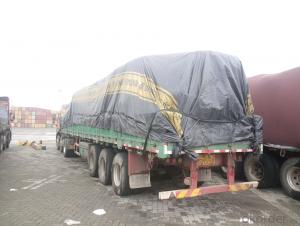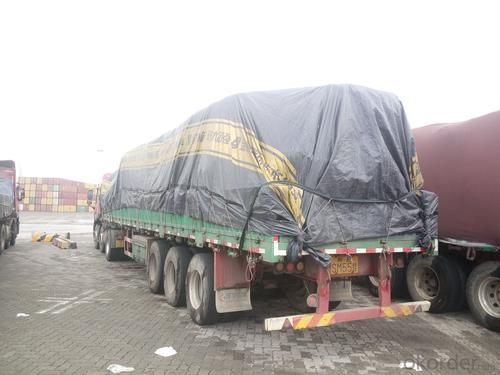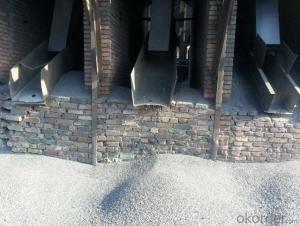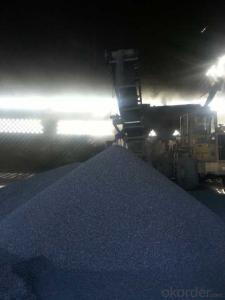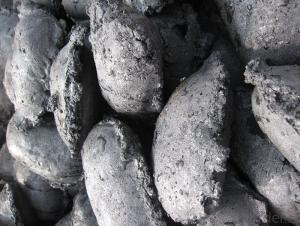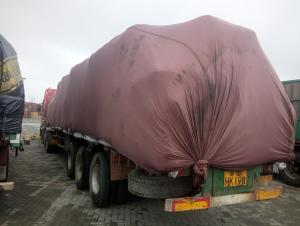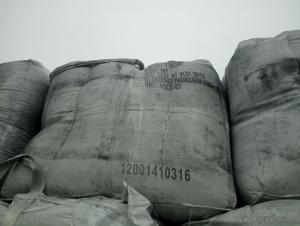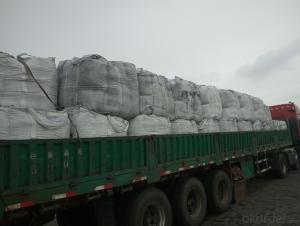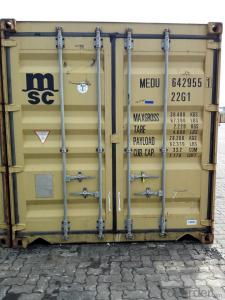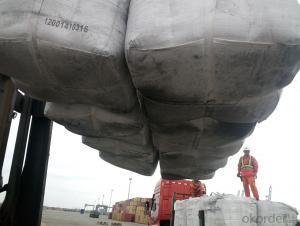Calcined Pitch Coke with Ash 0.5%max for Steel Mills
- Loading Port:
- Tianjin
- Payment Terms:
- TT OR LC
- Min Order Qty:
- 29 m.t.
- Supply Capability:
- 8000 m.t./month
OKorder Service Pledge
OKorder Financial Service
You Might Also Like
Introduction
Pitch Coke/Coal Tar Pitch is a kind of black brittleness and blocky piece, lustrously at normal temperature. It has special odour and poisonous and can be easily flame when melting, second-grade inflammable solid.
Pitch Coke/Coal Tar Pitch is obtained from powerfully processed coal tar. Compared to petroleum asphalt, the adhesiveness is better. Coal Tar Pitch is high quality tar production with high fixed carbon. It has excellent adhesion, waterproofing and resistance against seawater, oil and various chemicals. In these properties, it is much better than petroleum asphalt tar.
It can be used to produce painting, electrode, pitch coke, and tar felt. It also can be used as fuel and the raw material of asphalt carbon black.
Features:
The morphology, chemistry and crystallinity of recarburisers have a major impact on the overall casting cost. The combined application and cost benefits, which are derived through the use of Desulco, enable foundries to manufacture castings in a highly cost effective manner.
reduces
Recarburiser consumption
Power consumption
Inoculant consumption
MgFeSi consumption
Furnace refractory wear
Scrap rate
Tap to tap time
Slag inclusions risk
Chill
increases
Casting microstructure
Productivity
Process consistency
Carbon Recovery
Compared with calcined petroleum coke, acetylene coke and
graphite electrode scrap, Desulco yields the highest carbon
recovery and fastest dissolution time
Specifications:
CPC | |||
F.C.% | 98.5MIN | 98.5MIN | 98MIN |
ASH % | 0.8MAX | 0.8MAX | 1MAX |
V.M.% | 0.7 MAX | 0.7 MAX | 1 MAX |
SULFUR % | 0. 5MAX | 0. 7MAX | 1MAX |
MOISTURE % | 0.5MAX | 0.5MAX | 1MAX |
Pictures:
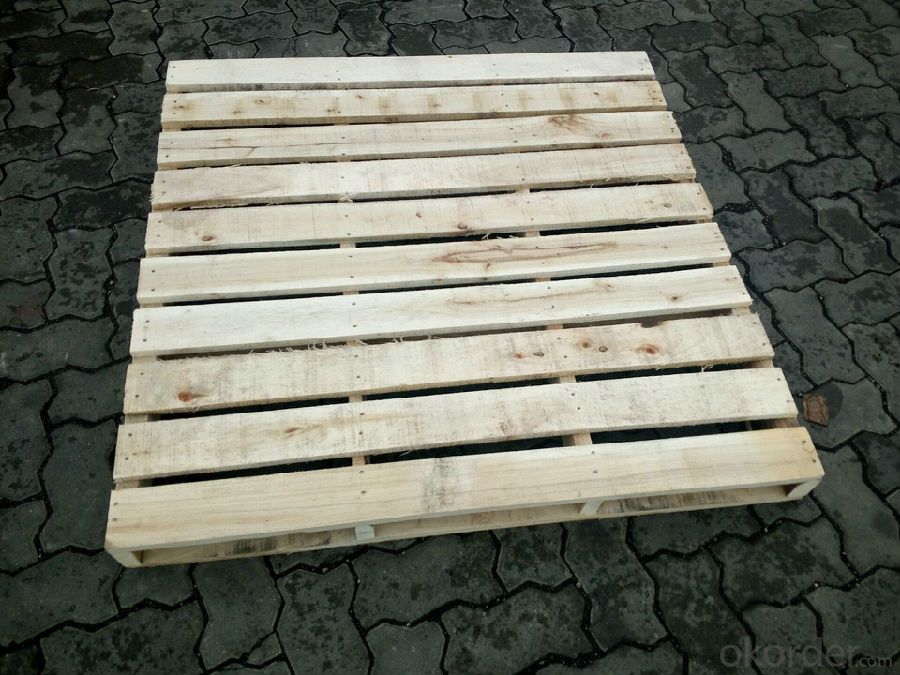
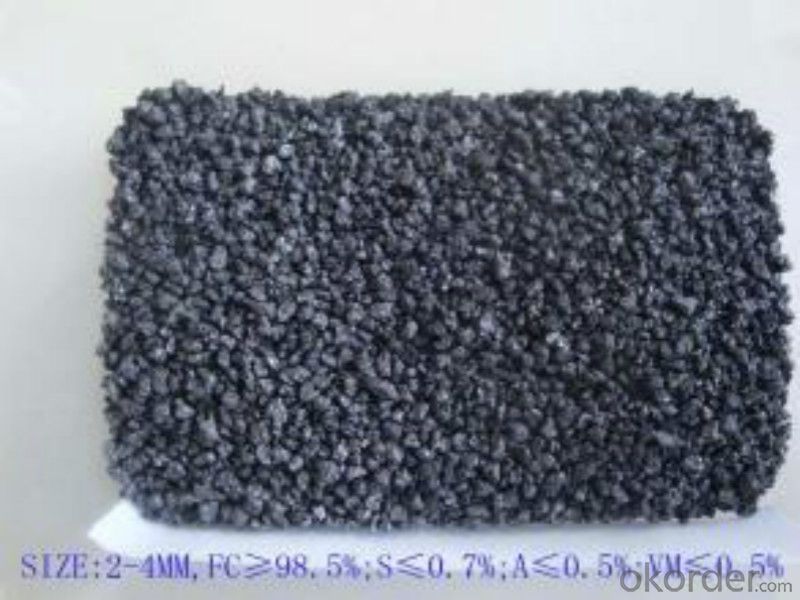

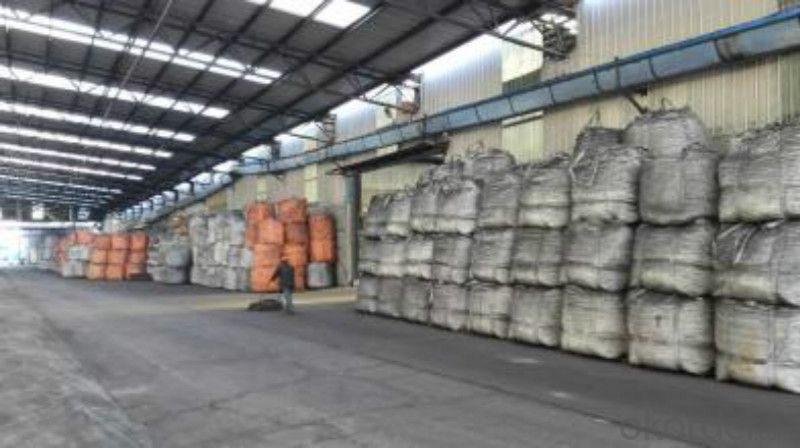
FAQ:
1.MOQ:2 Containers |
2.Size:1-3mm,1-5mm,2-6mm,3-5mm and as the customer's requirement |
3.Packing: 1 ton jumbo bag or 25kgs paper in bag |
4.Payment:T/T or L/C at sight |
5.Delivery time: within 15 days after receiving the deposit |
6.Usage: it is as carbon raiser,widely used in steelmaking,casting,casting iron,steel foundry,aluminum metallury. |
- Q: How does carbon cycle through living organisms?
- Carbon is exchanged and recycled among different parts of the Earth, including living organisms, in a process known as the carbon cycle. Living organisms primarily acquire carbon through photosynthesis, where sunlight, carbon dioxide, and water are used to produce glucose and oxygen. Plants absorb carbon dioxide from the atmosphere and convert it into glucose, which serves as an energy source for their growth. Some glucose is immediately utilized by plants, while the excess is stored as starch and other carbohydrates. This is how carbon is initially incorporated into living organisms. Consumers, such as animals, obtain carbon by consuming plants or other animals that have consumed plants. When animals consume plants, the stored carbohydrates are broken down into glucose, releasing carbon dioxide through cellular respiration. Animals use glucose as an energy source for their own metabolic activities. When animals and plants die or produce waste, their organic matter decomposes, releasing carbon back into the environment. Some of this carbon is converted into carbon dioxide through decomposition and returned to the atmosphere. However, decomposers like bacteria and fungi convert a significant portion of carbon into organic compounds that can be utilized by other living organisms. The carbon cycle continues as carbon is constantly exchanged between the atmosphere, living organisms, and Earth's reservoirs such as the oceans and soil. Carbon can also be stored for extended periods as fossil fuels like coal, oil, and natural gas. When these fuels are burned for energy, carbon dioxide is released into the atmosphere, contributing to the greenhouse effect and climate change. In summary, the carbon cycle is a complex process involving the continuous exchange and transformation of carbon between living organisms and the environment. It is critical for maintaining carbon balance in our ecosystem and plays a significant role in regulating the Earth's climate.
- Q: Well, recently, the carbon cycle has suddenly come up with a lot of questions. What's the definition of carbon and light carbon? What are the characteristics, and what are the differences between the two?
- The organic matter is composed of recombinant LFOM was completely decomposed residue or, to re synthesis of aromatic substances as the main organic matter (mainly humus), its stable structure is complex, in fact this part of organic matter in soil clay is a combination between, or in the process of the formation of soil aggregates Among the internal organic matter enclosed in aggregates, plays a very important role in maintaining the structure of aggregates, it is difficult to be utilized by microorganisms, soil carbon pool is stable. The content of 2 components of features from a certain extent that the carbon sensitive to climatic and environmental changes of the reaction.
- Q: How are carbon fibers produced?
- Carbon fibers are produced through a multi-step process known as carbonization, where a polymer precursor material, usually made from polyacrylonitrile (PAN) or pitch, is heated and chemically treated to remove non-carbon elements. The resulting material is then subjected to high temperatures in an oxygen-free environment, transforming it into a carbon-rich fiber. This process creates strong, lightweight carbon fibers with excellent mechanical properties, making them ideal for various industrial applications.
- Q: How about Zonta carbon technology
- The factory garbage to death, wages do not rise, but down, quarterly awards fell by more than half, production targets set very high, employees can not reach the goal, not to work overtime. This is a company's way of restricting employees to work overtime. And so on, the target production has been added, so never meet the requirements, overtime do not think. A large piece of employee turnover now
- Q: What is carbon black dye?
- Carbon black dye is a type of dye that is derived from carbon black, which is a fine black powder made from the incomplete combustion of hydrocarbon materials. It is commonly used as a pigment and dye in various industries, including the manufacturing of ink, paint, rubber, plastics, and textiles. Carbon black dye is highly valued for its intense black color and excellent lightfastness, meaning it does not fade easily when exposed to sunlight or other sources of light. Due to its strong coloring properties, carbon black dye is also used to add depth and darkness to other colors, making them more vibrant and visually appealing. Additionally, carbon black dye is known for its good heat stability, chemical resistance, and electrical conductivity, making it suitable for a wide range of applications.
- Q: What are the consequences of increased carbon emissions on social inequality?
- Increased carbon emissions have significant consequences on social inequality. Firstly, the impacts of climate change, driven by carbon emissions, disproportionately affect marginalized communities who often lack the resources and infrastructure to adapt or recover from extreme weather events, such as floods, droughts, and storms. This exacerbates existing inequalities and widens the gap between the rich and the poor. Secondly, the burning of fossil fuels, a major contributor to carbon emissions, disproportionately affects low-income communities who are more likely to live near industrial areas or power plants. This exposure to air pollution leads to higher rates of respiratory diseases and other health issues, further deepening social inequality as access to quality healthcare is often limited for these communities. Moreover, the consequences of climate change, such as agricultural disruptions, water scarcity, and increased food prices, can lead to social unrest, migration, and conflicts, disproportionately impacting vulnerable populations. This creates a ripple effect on social and economic stability, further marginalizing already disadvantaged groups. Addressing carbon emissions and mitigating climate change is crucial for reducing social inequality. Transitioning to renewable energy sources, investing in sustainable infrastructure, and implementing policies that prioritize the needs of marginalized communities can help alleviate the burden on those most affected and promote a more equitable society.
- Q: Why carbon fiber resistant to low temperature
- Resistance to 180 DEG C carbon fiber can be low temperature, under this condition, many materials are brittle, even sturdy steel has become fragile than glass, and carbon fiber under this condition is still very soft.
- Q: How does carbon impact the formation and intensity of hurricanes?
- The formation and intensity of hurricanes are significantly influenced by carbon, specifically carbon dioxide. The rise in atmospheric carbon dioxide levels is a result of increased carbon emissions from human activities such as burning fossil fuels, deforestation, and industrial processes. This increase in carbon dioxide contributes to global warming. Global warming is caused by the greenhouse effect and leads to higher sea surface temperatures. These warmer ocean waters provide the necessary energy and moisture for hurricanes to form and strengthen. As the atmosphere warms, it can hold more water vapor, which acts as fuel for hurricanes, making them more powerful and intense. The warming of the atmosphere also changes the conditions that affect hurricane formation. It alters the wind shear, which is the difference in wind speed and direction at different altitudes. Low wind shear is favorable for hurricane development as it allows the storm to organize and gain strength. However, global warming can disrupt this balance and create unfavorable wind shear patterns, hindering hurricane formation. Additionally, the increased levels of carbon dioxide in the atmosphere contribute to ocean acidification. When carbon dioxide dissolves in seawater, it forms carbonic acid, which lowers the pH of the ocean. Acidic waters have detrimental effects on marine life, including coral reefs. Coral reefs act as natural barriers against storm surges during hurricanes, but their degradation weakens their ability to protect coastal communities. In conclusion, carbon emissions and the subsequent increase in carbon dioxide levels have a significant impact on the formation and intensity of hurricanes. The warming of the atmosphere and ocean, along with changes in wind shear patterns, create conditions that favor the development and intensification of hurricanes. Additionally, ocean acidification resulting from excessive carbon dioxide levels weakens natural defenses against storm surges. It is essential to address carbon emissions and reduce our carbon footprint to mitigate the potential consequences of climate change and its impact on hurricanes.
- Q: How does carbon dioxide affect ocean acidity?
- Ocean acidification, a process caused by the presence of carbon dioxide, is responsible for the increased acidity in the ocean. Human activities, such as the burning of fossil fuels, release carbon dioxide into the atmosphere, and a significant portion of it is absorbed by the oceans. This excess carbon dioxide reacts with seawater and forms carbonic acid, which then dissociates into hydrogen ions and bicarbonate ions. The rise in hydrogen ions reduces the ocean's pH level, resulting in increased acidity. The elevated acidity of the ocean negatively impacts marine life in several ways. Marine organisms, including corals, shellfish, and plankton, are unable to construct and maintain their calcium carbonate structures, such as shells and exoskeletons, due to this condition. This can lead to slower growth rates, weakened structures, and higher mortality rates among these organisms. The survival and reproduction of various species, including fish and other marine animals, are also affected by ocean acidification. The changes in water chemistry disrupt their physiological processes, making it difficult for them to navigate, find food, and evade predators. Moreover, the increased acidity can alter the behavior and development of certain species, potentially causing changes in ecosystems and a decline in biodiversity. Ocean acidification can also have a cascading effect on the entire marine food web. Phytoplankton and other primary producers, which are the foundation of the food chain, may suffer due to the changing ocean chemistry. Consequently, the organisms that rely on them for sustenance are also impacted. This disruption can have far-reaching consequences for the entire ecosystem, including commercially valuable fish species and the livelihoods of coastal communities that depend on them. In conclusion, the emissions of carbon dioxide contribute to ocean acidification, which has severe consequences for marine life and ecosystems. It is crucial to comprehend and address this issue in order to safeguard the health and sustainability of our oceans and the countless species that depend on them.
- Q: Rod box material, there is a kind of material called carbon fiber, who knows this material is good?
- Very good, carbon fiber is made of organic fiber after a series of heat treatment into, inorganic fiber with high performance carbon content is higher than 90%, is a new material with excellent mechanical properties, the intrinsic properties of natural carbon material with, and both the textile fiber soft processing, is a new generation of fiber. Carbon fiber is a new dual-use material for military and civilian use. It is the key material of technology intensive and politically sensitive. It is the only material that does not drop in the high temperature inert environment above 2000 degrees celsius. Carbon fiber steel accounted for less than 1/4, the tensile strength of composite is generally above 3500Mpa, is 7-9 times that of steel, carbon fiber has superior corrosion resistance, it can also be safe and sound in the dissolution of gold and platinum "aqua".
Send your message to us
Calcined Pitch Coke with Ash 0.5%max for Steel Mills
- Loading Port:
- Tianjin
- Payment Terms:
- TT OR LC
- Min Order Qty:
- 29 m.t.
- Supply Capability:
- 8000 m.t./month
OKorder Service Pledge
OKorder Financial Service
Similar products
Hot products
Hot Searches
